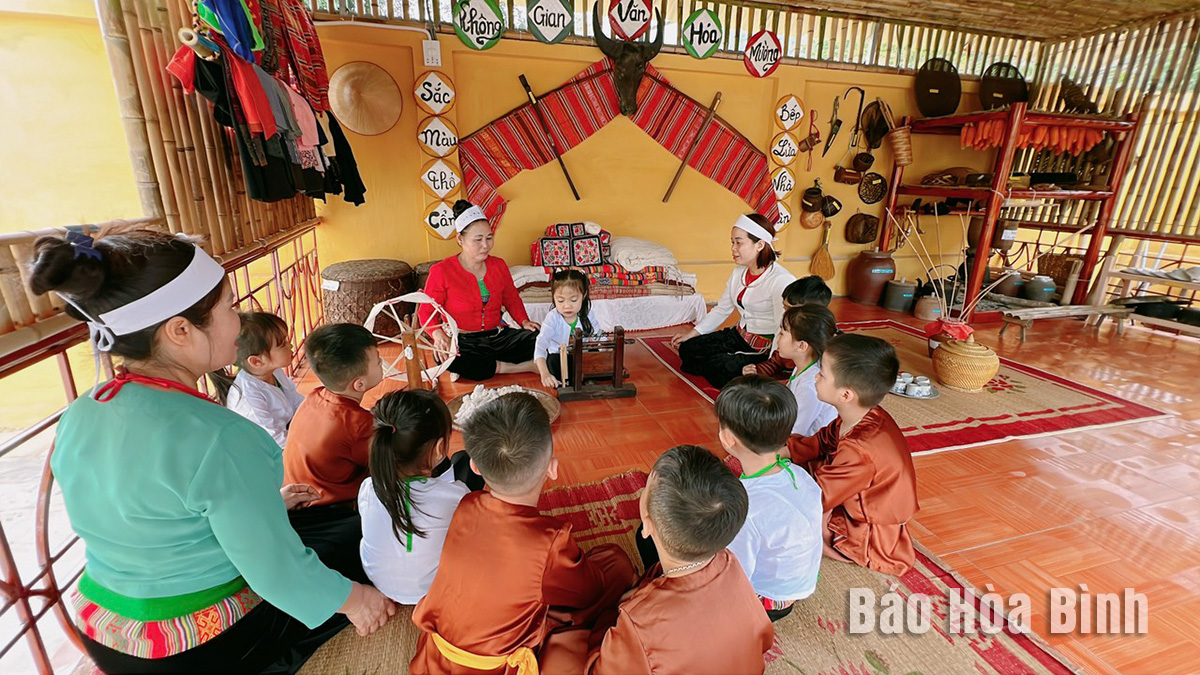
The Bac Son pre-school in Hung Son commune, Kim Boi district is effectively implementing a model of preserving and promoting cultural identity of the Muong ethnic group.
The miniature Muong stilt house model with an
area of about 21sq.m, fully equipped with the Muong people’s daily necessities,
production tools, traditional musical instruments, has attracted the curiosity
of children every time they are introduced by the teacher. Every week, children
have two lessons in this space. In addition to guiding children to explore the
cultural space and daily life characteristics of the Muong people, and playing
many folk games, teachers also teach basic skills to children.
Teacher Bui Thi Linh said that each experiential
lesson at the stilt house helps children understand more about the Muong
cultural identity and develop many skills. Little girls like to wear Muong
dresses to school and practice playing gongs.
The pre-school has two facilities, with the
nearly-20-million-VND (788 USD) stilt house located at the main one in Hoi Tram
hamlet, Hung Son commune.
Principal Bui Thi Hue said that in each lesson,
teachers guide children to learn and discover the names and uses of utensils
and items for daily life and production in both Kinh and Muong languages. The
pre-school also regularly coordinates with the representative board of parents
to organise tours to hamlets for children to meet with the elderly who can
teach them Muong folk songs and stories; and visit old stilt houses.
Gongs hold a special place in the cultural and spiritual life of the Muong ethnic people in Hoa Binh province. More than musical instruments, they are an indispensable part of community rituals and collective memory, echoing through generations as a spiritual thread linking the past, present, and future.
Preserving and promoting the cultural values of the Muong ethnic group has become an urgent task in the current context, as many traditional values face the risk of fading away. This effort requires not only protecting the cultural identity but also eliminating outdated customs and developing a modern cultural lifestyle, contributing to sustainable values for the Muong community in Hoa Binh province.
The Muong ethnic culture, deeply rooted in Vietnam’s mountainous north, continues to be preserved and revitalised by dedicated individuals and communities determined to safeguard their ancestral identity.
The Muong group is one of the largest ethnic minorities in Vietnam, primarily found in Hoa Binh province. The Muong people in Hoa Binh boast a rich and diverse cultural treasure that reflects the unique identity of this ethnic group. Accounting for over 63% of the province's population, they have created and preserved numerous distinctive cultural values, contributing to their unique identity. Their cultural heritage is an invaluable asset, at the heart of their national identity, and represents a vibrant spiritual life that must be preserved and promoted in today’s modern world.
For generations, the ethnic communities of Hoa Binh province, particularly the Muong people, have preserved vibrant festivals deeply intertwined with the region’s geography, nature, and social traditions. These celebrations enrich Hoa Binh’s spiritual life and cultural identity, reflecting both folk beliefs and the intermingling of ethnic customs. Many of these festivals have endured the test of time, passed down through generations and continuing to thrive today. Among them, the Khai Ha (Going Down to the Field) festival stands out as one of the most significant events of the Muong ethnic group.
Muong calendar, known as sach doi, is an ancient folk knowledge system developed through observations of the movement of the pleiades star. This unique calendar consists of 12 bamboo sticks, each representing a lunar month. Specific days within each month are marked with distinct symbols, guiding locals in determining auspicious and inauspicious days for important activities.


